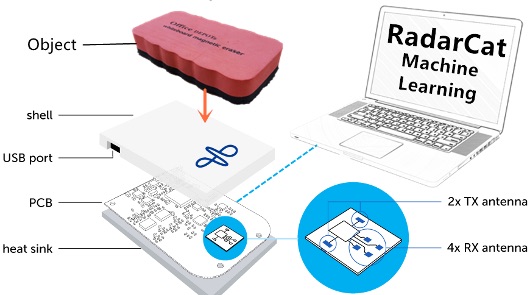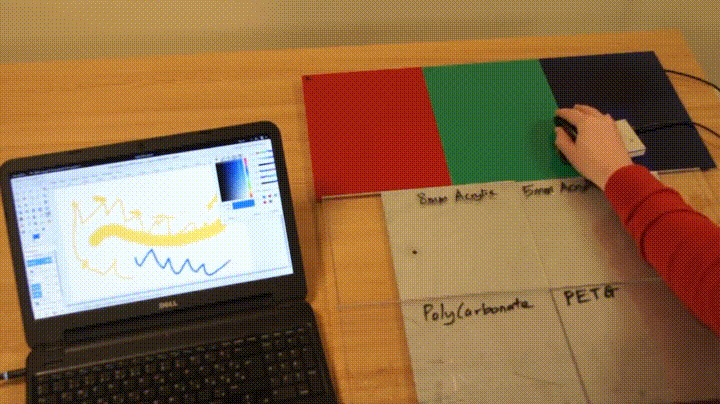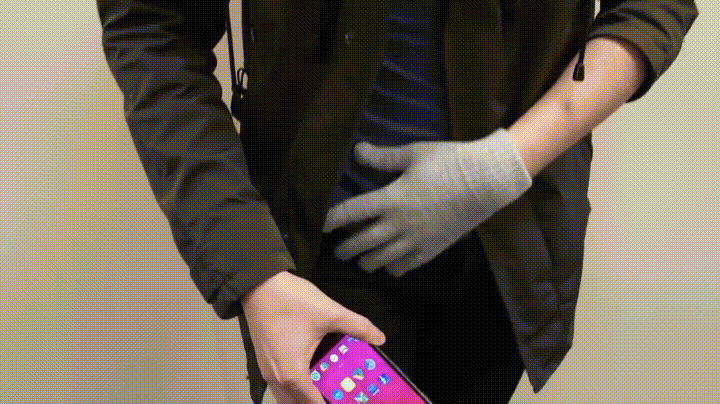RadarCat recognizes the objects and materials from which they are made.

Many sci-fi works describe devices that can, in a contactless way, recognize objects and chemical compounds from which they are made. Even in the WALL-E cartoon there is such a device - it is equipped with an EVE robot who was able to identify a living plant without direct contact with it.
Now a similar device is trying to create representatives of the University of St. Andrews . A prototype of this type of system is ready; it allows you to determine the shape of an object, identify the object itself and what it is made of.
Called RadarCat (Radar Categorization for Input & Interaction using Soli) device is named. It is based on technology created by Google, called Project Soli . The work of its prototype project team showed in the video.
Project Soli is a technology first introduced by Google in 2015. The Google team has been conducting research for some time, which was aimed at studying the range of frequencies emitted by the human body when performing movements. According to the results of research, an interesting conclusion was made that the human body is an interface for interacting with the outside world, and fingers are reliable tools for interaction.
')
Taking this statement as a basis, employees of Google, using a miniature radar system, were able to teach a computer to identify gestures made by man in the air, and to recognize these gestures as commands. The idea, in general, is not new, but here you can talk about the high accuracy of interaction with complex electronic devices. Application Project Soli can find, for example, in wearable electronics - for example, in smart watches. Now, to work with such a clock, you need to either touch the touchscreen with your finger or control the device with your voice. Using Project Soli, the owner of a device with a small display can simply swipe through the air, and the clock will gradually show different screens and applications.

In addition, it can be a wireless "air" keyboard. Recently, engineer Alex Bravo (Alex Bravo) has developed a new way of typing on the keyboard of a smartphone, just turning over in the air.
But back to RadarCat. This sensor, interacting with the Project Soli module, is able to identify some objects. For example, keyboards, mouse pads, glasses of water, copper plates and other objects. "Our invention uses a multi-channel radio installation, which, using signals from Project Soli sensors, can determine the characteristics of objects we are used to," the team said in a statement. "We tested several objects and materials, including transparent materials." Using the developed device, the user can choose the color and size of the brush for the graphic editor installed on a PC or laptop.

The system can be trained. For example, teach her to identify different parts of the human body. With this system, you can configure the phone to launch a specific application, if you bring the phone to the stomach. The device will “understand” that a person is hungry and will start looking for restaurants or cafes nearby where you can eat.

RadarCat can be used by employees in the restaurant industry to determine which beverage bottles are almost empty or to monitor the behavior of visitors to a restaurant or cafe. Is the glass empty? It is necessary to fill it.
Or the system can be used to help people with vision problems. In a store, touch does not always help - different liquids can be poured into the same container. RadarCat allows you to determine what kind of liquid it is, after which the digital assistant pronounces the name of the product, and the person knows what he is buying.

“Our technology can radically change the way a person interacts with a computer. New applications will be able to work with familiar objects that surround a person at home or in the office, ”says Aaron Quigley, one of the project team members. The developers say that their invention can be used in almost any sphere - from restaurants and cafes to industry and science. The power consumption of the chip, which is the basis of the Project Soli, and, consequently, the RadarCat is very small, so that devices with such a chip can work for a long time from a battery with a small capacity.
Source: https://habr.com/ru/post/398265/
All Articles